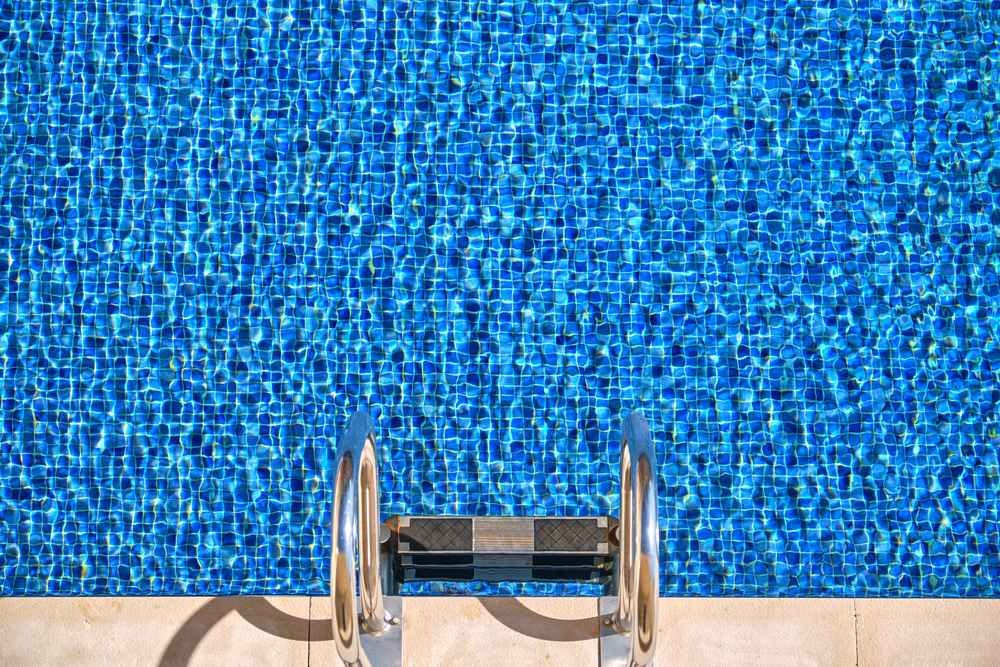How do you know when it is time to resurface your swimming pool? And if it is time for your swimming pool to have a facelift, what is the cheapest way to resurface? In this article we’ll tell you everything you need to know, including how long the process will take on average, from start to finish.

How do you know when your pool needs to be resurfaced?
How do you know when your pool needs to be resurfaced? There are a number of different tell-tale signs, here’s what to look out for:
- Plaster flaking or peeling: If you have noticed the plaster beginning to flake or peel on the surface of your swimming pool then this is a good sign that it’s time for a resurface
- Surface staining: If you have noticed some stains on the surface of your pool then this is likely due to copper, calcium, and salt. These will discolors the pool with a blue-grey crystal deposit (aka topical stains).
- Rough surface: If your once smooth swimming pool is now rough to the touch then this is a good sign it’s time to get it resurfaced once more.
- Cracks forming: If there are small cracks forming (aka check cracks) and they appear like faint spider webs or a slight crack in an eggshell then re-plastering or resurfacing will be a must.
- Plaster discoloration: If your pool was once a beautiful blue color but it has since started to fade and discolor it’s likely due to the UV rays. In this case, it’s a good sign that having a fresh surface installed is a good idea.
- Large structural cracks: If there are larger structural cracks forming in your swimming pool then this is an absolute confirmation that you need to have an expert come and look at it.
- Rust stains: Oxidization in the pool leads to small rust spots forming which will soon grow over time. These are unsightly so having your pool resurfaced is advised.
- Loss of pebbles: A decent pebble job should last several decades. If your pool finish has lost pebbles and is beginning to look bare then a resurfacing will be required to restore it.
- Cracks in steps and benches: If your swimming pool was poorly constructed initially, which has been the unfortunate case for many pool owners, there may have been “rebound gunite” used. If that is the case and you’ve spotted cracks forming in the steps and/or benches surrounding your pool, then a resurface will be essential.
- Paint or fiberglass issues: If the fiberglass has begun to delaminate and chalk the water in your swimming pool, or if the paint seems to be fading and falling away, then a resurface job will be required.

What is the cheapest way to resurface a pool?
So, what is the cheapest way to resurface a pool? On average, smooth pool plaster is the cheapest surface material and is available in a wide variety of colors. This starts off at around $2,600-$2,700 for an average-size pool.
If, however, budget isn’t so much of an issue then there are a number of more advanced pool surfacing options for additional aesthetic appeal, such as:
- Pebbledash
- Stones
- Shells
- Glass beads
- And more
For small-pebble surfaces, you could be looking at around $3,500 for an average-sized swimming pool, with the more premium surfaces such as glass beads coming in at around $5,000 and upwards.
How long does it take to resurface a swimming pool?
How long does it take to resurface a pool? This all depends on the method of resurfacing that you choose, the size of the swimming pool itself, and a number of other factors. On average, traditional swimming pool resurfacing can take about two days from start to finish. If you hire the professionals like West Coast Pool Resurfacing, here is an overview of what you can expect from them in terms of process:
- Drain the pool: First, the swimming pool will need to be drained of all water before the surfacing can begin.
- Prep the pool: Following that the pool will need to be prepped by removing the previous surface.
- Install any masonry as necessary: Next up, any newly selected masonry will be installed.
- Seal the pool: Following that, once the new surface has been installed the pool will need to be sealed properly so that there are no leaks.
- Install the swimming pool finish: Next they will install the pool finish of your choice, whether that be tile, pebble, or plaster.
- Clean the pool of debris: Once complete the pool will need to be cleaned thoroughly and all debris removed.
- Refill the pool with water: Now that that is complete the pool will be filled up with water once more.
- Treat the water: Now the water must be treated with the appropriate chemicals to get the perfect pH balance.
- Monitor pool: The pool will need close monitoring to ensure that there are no issues or leaks and that the process has been completed properly.
- Voila: And there we have it! The swimming pool resurfacing has been completed and you are good to go.
Again, this entire process shouldn’t take much longer than two days to complete from start to finish.
Conclusion
To recap, there are many signs that can indicate that a pool resurface is required. Keep an eye out for the issues listed above so that you can decide when the best time is for you to contact your local pool resurfacing company.
There are many different types of swimming pool finish, but the cheapest and most affordable is a smooth pool plaster.
The process should take approximately two days depending on the size and complexity of the job. We hope that you have found this article helpful and wish you the best of luck with your pool resurfacing project.










